Wolf Centos
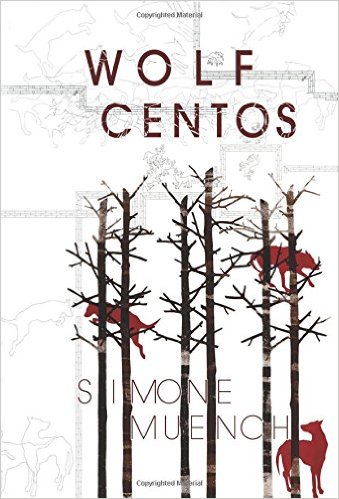
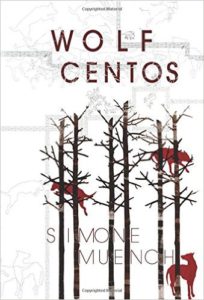 by Simone Muench,
by Simone Muench,
Sarabande Books, 2014,
66 pages, paper, $14.95,
ISBN: 978-1-936747-79-5
Buy this Book
The ancient form of the cento provides a beautiful excuse for us to revel in the poetic line and in the craft of our literary forbears: named for the Latin word for a patchwork cloak, the cento calls for its creator to piece together individual lines from the works of other poets. In Wolf Centos, Simone Muench assembles an entire collection of these patchwork poems, all in service of one common, evocatively wild object of meditation: the image and symbol of the wolf.
Muench draws upon a pantheon of greats for her lines — from Akhmatova to Yeats, Atraud to Jake Adam York — and a natural first instinct is to try to identify each author, to deconstruct Muench’s cloaks back to their original fabrics. (“Sans teeth, sans eyes” — Shakespeare. “I shall speak not of myself, but of geography” — Neruda.) Soon, though, we come to focus less on the source of each line than the textures, colors, and music for which Muench chose it, and she’s plucked some striking ones. But the cento’s real art lies not just in choosing individual lines, but in arranging them: we look for the flow or leap between lines, for resonance or juxtaposition, for how the assembled pieces build and sustain meaning and momentum. Do the patches not only create a new whole, but transcend their piecemeal sum? At their best, Muench’s stanzas turn with luminous, startling clarity:
I take a wolf ’s rib & whittle it
into little months, little smokes
& oblivion.
And here, relish the tinged tactility of Muench’s piecework:
The theory
of light is broken: the room dark
as black mullein, a clutch
of burnt paper. Every face a stain.
Muench wisely breaks up her volume of centos — each of which is titled “Wolf Cento” — into four sections. The first section’s epigraph, from the screenplay of The Doors, is delivered with a playful deadpan directed at Jim Morrison’s wife (“All the poetry has wolves in it, Pam.”); the next one is from T. S. Eliot: “These fragments I have shored against my ruins.” Her use of Eliot suggests that such an archaeological act as the crafting of a cento is not just creative, but survivalist.
Over the progression of her four sections, Muench offers a range of variations on what the wolf might mean to us. Wolves seem sometimes to represent an inner human strength, something ancient and feral: “In the space of a half-open gold door / your body’s animals want to get out.” Other times, the creature is a strange Other that we both fear and envy from a distance: “We: spectators, always, everywhere . . . / we wanted to be wolves.” In or around the wolf there is also a human love, a lust (“Eros is a wolf, Caesar”), a loss. The wolf reminds us of our human limitations (“More & more I see the human form, / a nothingness which longs to be the sea”), but Muench also reminds us of the possibility for communion, and for transformation thereby:
“I have lost my being in so many beings.” Finally, the wolf presents the possibility of salvation, a way to save our wildness in the face of loss, civilizational clutter, and time: “Shrewd wolf of dark innocence, / rouse us from blur. Call us.” We are encouraged to consider the wolf in the spirit that Stevens asked we consider the blackbird: “The question of the wolves turns and turns.”
In a project of such singular focus, some missteps and weaker moments are inevitable. Given dozens of “wolf” lines culled from the canon and beyond, some are bound to court wolf-cliché (“we licked the blood from our paws”), and Muench’s lines sometimes just feel like a patchwork of good lines. And, over time, despite the pacing device of the section titles, the book’s momentum flags a little, and it isn’t helped by the continually reiterated “Wolf Cento” at the top of each page.
But at its best, Muench transcends the centuries and continents she spans. Reading Wolf Cento offers not only myriad gleams of beauty and strangeness, but also the comforting sense of submerging in a rich collective consciousness of what we’ve written. The result is sometimes diffuse, dizzying, not to be read for literal coherence. Read these poems instead like meditative mysteries, as one reads the cumulative couplets of a ghazal. Delight in this evidence that our works and days — and our best lines — can be woven and rewoven into so tangible a pleasure. Praise the luxury of inheriting so many good ones.
— Megan Grumbling
Parallax
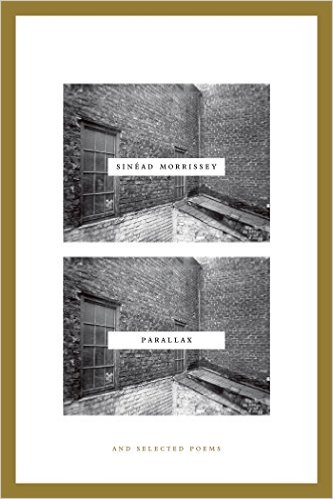
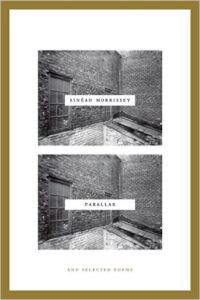 by Sinéad Morrissey,
by Sinéad Morrissey,
Carcanet Press Limited, 2013,
69 pages, paper, £9.95 ($15.56 USD),
ISBN: 978-1-84777-204-6
Buy the Book
Hold your finger out in front of you, close one eye, then quickly open it and close the other. Rapidly switching back and forth, you will see your finger shift from left to right and back again. This displacement, or shift in apparent position of your finger seen from different points of view, is parallax. Parallax is measured by the angle of inclination between these two points of view and the object. Astronomers use the principle of parallax to measure the distances to closer stars, and photographers know parallax error as the difference between what is seen through the viewfinder and what is captured by the lens in a single-lens reflex camera. It is this reference, to the shifts that affect optical perception, that is initially most applicable to the poems in Sinéad Morrissey’s extraordinary collection Parallax, the winner of the 2013 T. S. Eliot Prize.
Inspired initially by the discovery of a trove of 1911 plate glass negatives of Belfast’s slums taken by Alexander Robert Hogg, Morrissey’s poems use ekphrasis to confront the radical possibilities of seeing and not seeing, of truths and lies, and of looking at and looking away. The poems are replete with photography and film, with television screens and early viewing devices, with blindness and light. In “The Mutoscope,” early motion picture viewing devices rattle to life for the singular viewer:
Only for you do the two mute girls on stage
who falter at first, erratic as static
in the synaptic gap between each image,
imperceptibly jolt to life —
grinning, tap-dancing, morphing into footage,
their arms like immaculate pistons, their legs like knives . . .
It lasts a minute, their having-been-written onto light.
Morrissey’s use of internal rhyme punctuates the poem as it, like the mutoscope, picks up speed. This rhythmic coming to light, and to life, is repeated throughout the volume, often in contrast to a reciprocal darkening. In “Home Birth,” as in “A Matter of Life and Death,” the arrival of one person eclipses another. In the latter poem, the actor David Niven flickers across the 1946 film of the same title, ascending a giant stairway to heaven as the speaker in the poem gives birth and recalls the recent death of her grandmother.
The poems navigate these exits and entrances, and questions of perspective, through masterful poetic form. In “Fur” we discover Holbein’s famous anamorphic skull, appearing as “driftwood / up-ended by magic from the right hand-side / of the tesserae carpet” in his 1533 painting, The Ambassadors. And even as the speaker in “Photographing Lowry’s House,” a persona poem imagining the experience of photographer Denis Thorpe, recognizes the effect of erasure his photographs simultaneously have on the artist’s life — as breath has on drawings of fawns in the caves of Lascaux — other actors in the poems engage in more willful concealment and erasures. For example, “The Doctors” imagines photographic alterations in Soviet-era Russia before Photoshop: “With scissors, / nail files, ink and sellotape, he has been vanished — / alongside other party operatives who touched / his sleeve.”
Throughout Parallax, in addition to poems that regard photography and film, there are other poems that explore Russia from differing perspectives. The sonnet “Puzzle” responds to a popular 1950s Soviet book of mathematical puzzles, and “Shostakovitch” imagines the composer writing under the restrictions of the Great Terror. Metaphorically and philosophically, parallax can also be considered a literary tool by which an author presents the same story from different points of view.
From one man’s sudden onset of blindness, to wanting to look away from flies on a dead rat, to a speaker’s observations in the poem “Shadows” that they “retract [ . . . ] back like drowning soap,” the interdependent play of light and darkness is revealed, and the double nature of light leaves its mark: “Shadows of candles on church walls at Evensong / manifest not as flame, but as smoke.” In “Lighthouse,” the speaker’s son lies awake at ten in the waning light of late summer solstice,
a lighthouse starts its own nightlong address
in fractured signaling; it blinks and bats
the swingball of its beam, then stands to catch,
then hurls it out again beyond its parallax.
Here, counting “each creamy loop” and “each well-black interval,” the boy enters a world that is only partly visible, “partly seen.”
Because our eyes have different and overlapping fields of vision, parallax is what allows us, through stereopsis, to perceive the world in three dimensions. This effect is what the poems in this volume full of electricity offer us: more seeing, more revelation and doubt, greater depth.
— Julie Poitras Santos
Down
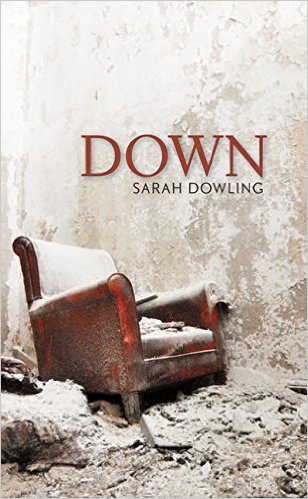
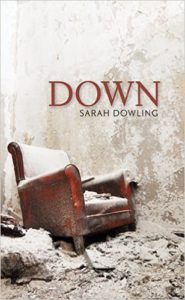 by Sarah Dowling,
by Sarah Dowling,
Coach House Books, 2014,
88 pages, paper, $17.95,
ISBN: 9781552452981
Buy the Book
Sarah Dowling’s Down ends with a process note, which is where I began reading. Dowling offers up her source texts, which include songs by the Temptations and Aaliyah, Frank Ocean’s coming out letter, Frank O’Hara’s poem “Morning,” and an interview with Andy Warhol, among others. Because these sources were unfamiliar to me, I went searching for the original texts to better understand the ways that Dowling “flattened” the language as she worked through the project. The research became the poems as I read O’Hara’s “Morning” while listening to Ocean’s “Lost,” unknowingly also hearing a recitation of O’Hara’s poem overlaid on the song. This is how I can best describe these poems: the words morph into one another to create a new narrative — sometimes familiar and sometimes disorienting. They contain threads of love and danger; they feel new at the same time as they feel known. These are poems to live with until they are in your veins, like songs.
Dowling’s explanation of her process helped me to see the complexities of thought that create these poems’ form. Thinking about process took me into the making of a book, which includes the finishing. Here, Coach House delivers a book as well-crafted as the poems on the page. First, I am taken by the texture of the paper and the texture of words and space. The text creates a sense of wandering into the gaps between intimacy and secrecy.
The poems speak to the reader in low tones, call us “Honey” and “Baby,” get down to the birds and the bees from the beginning. “Sunshine Honey” immediately creates an intimacy between reader and poems — we are connected by the familiar song, the sex and the sexlessness, the distance and the longing for some other feeling. Except that we don’t really know who this “me” is — it’s like having sex on a first date. We are feeling and being with the body of the poems, but we haven’t had many conversations, so we’re not sure what this narrative is all about. It takes a few readings to delve into the depths that Dowling offers us in Down, but it’s worth the exploration. She asks:
What could make this aesthetics. What could make me feel
that. Make me many. Make me better. What could make me
sexless and sexual. Make me feel we. Make me feel made.
Make me feel us. Make me feel matter. Make me feel this,
for one. What could make me feel this commotion, this
relationship to energy. What could make me feel this way.
The poems teach us how they “make this aesthetics” — they layer what is familiar with what is completely disorienting. We come through the first section of the book feeling a little bit wooed by the words. This is a fragile kind of adventure. We want to keep feeling this way, so we turn the pages over and over, keep being that somebody who is reading. We get sentimental. We get dreamy. We want to tell someone else how we feel. And so do the poems.
Later, the book moves into darker spaces. The text juxtaposes sunshine and beaches with house fires and graves. The spaces between words create more deliberate disorientation. The feeling of not knowing where you are, where the burial is taking place, comes over you. This crescendo peaks with the poem “Starlight Tours”:
winter taken screaming he on
night out bitterly outskirts
bitterly kneel
on him last cold on the
seen nights river
cold of cold and
winter November
The poems in Down settle us firmly in the hinterlands, in the “waste fields around ports and airports,” in the “locations of secret pleasure and concealed terror.” Dowling takes us into warmth and desolation, speaks to us sweetly in a language that we do not quite yet understand.
These poems will keep you company at night, and remind you simultaneously of our interconnection and our isolation. Down offers intimacy and asks you to do the work that is required to maintain it. This is a book of relationship and revelation, surrender and devotion. These are poems you’ll want to keep near you as you the weather transitions. Read Down — let it sing to you.
— Cathleen Miller
Jesus Was a Feminist and other Poems and Same Old Story
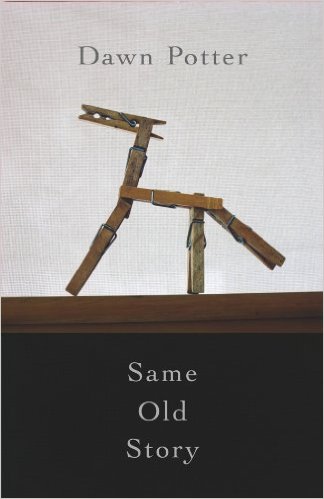
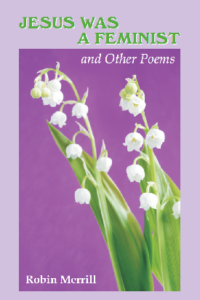 Jesus Was a Feminist and other Poems,
Jesus Was a Feminist and other Poems,
by Robin Merrill,
Moon Pie Press, 2014,
36 pages, paper, $12,
ISBN: 978-1-4951-0361-2
Buy the Book
 Same Old Story,
Same Old Story,
by Dawn Potter,
Cavan Kerry Press, 2014,
87 pages, paper, $16,
ISBN: 978-1-933880-40-2
Buy the Book
Earlier this year, poets Dawn Potter and Robin Merrill both came out with new books. They write very different poems. But because they both write about rural Maine, about the tough lives of those who live on the margins, and about the place of women in a predominantly male culture, they are an excellent study in the difference between spoken word /slam poetry and formal lyrical verse.
With a slam poet — and Merrill is one of the best — the pace of the poem rushes forward as if it can’t delay, and, if it does, the race is off. She uses, as any skilled public speaker, a range of rhetoric techniques to heighten the intensity of the poem and to press it toward its conclusion. In a poem “Hello Wagon,” about getting sober, she spills out her feelings using anaphora and parallelism. Notice how quickly these lines read:
I don’t care what those dastardly demons put in our path
what hurdles, what cliffs, what fire-breathing dragons. . . .
I don’t care what ghosts pay me a visit.
For Potter, in contrast, in her poem “Son-In-Law” about a ne’er-do-well young man, the poem thrives in the delicious hesitations, the gradual building up of a sentence, even the break of a stanza, so that it can spring open and release. Her parallelism is used to set a scene:
. . . while she was emptying last year’s freezer-wizened beans
into the chicken pail, while she was counting
cans of juice and packages of pork chops.
Here the two subordinate clauses are packed with elaborate details and with activities that ask us to dwell on an image. In the third-person voice, the poem lets us watch the woman interact with her son-in-law and, by the exchange of words, we find that he’s still like “The boy he used to be, / the one she recalls at summer Bible School, / pouring Kool-Aid on her little girl. . . . ” There’s no rush to the startling, painful conclusion of the poem. Like a fine musician of words, she lets each word note sound its distinct tone to create its full harmony.
But when Merrill introduces love in “Louisiana Sharecropper’s Chapel,” we’re flung immediately into a moment with a sentence that runs everything together:
And often, I’d only be across the aisle, my tongue so far down
Steve Davis’s throat that I could taste the black licorice he’d snuck
the night before.
Full of lovely sensual details, these lines leap into sexuality with him “unbuttoning that thrift store dress” and her, in church, “calming [her] breathing lest the deacons think” she’s “been touch by the Spirit.” With humor and directness, we experience sensuality with no brakes on. Potter, however, lets the love moment unfold itself line by line, the sentence pulled apart so every move is distinct and gradual, as in her poem “Letter to Will”:
Last night he
Ran his hands
Through my hair,
Down the nape,
Of my neck,
Kissed me between
The shoulder blades,
And so on.
Her words aren’t in a rush. They linger over an image, as in “Dog in Winter” where the phrasing delays in revealing the subject for four lines: “Up the boggy headland, frozen now, where a stone fence / submerged in the snow and earth-sink hints at pasture / so long vanished that the woods are convinced / grassland never existed, two bodies climb. . . . ” Her poems relish delays.
But that does not make Merrill’s poems any less forceful. It’s just that the demands of spoken word, the way the format of a slam is set up — you have to recite in a minute or three minutes a poem that will grab the attention of the judges — delays and hesitations are the death knell of a poet. You need to get their attention and, in quick order, set up a situation, a narrator, and some tension that, after some elaboration, can be resolved quickly. So her poems tend to jump at you the way a salesman on the phone launches into a spiel.
Potter’s poems invite you on a leisurely walk on an unfamiliar pathway where, much to your surprise, you find, as in “Cinderella Story,” a dove:
She crouches, hogging the feeder tray,
pebble-eyed and jaunty despite the ice cube
that, for two arctic days, has encased her pink left foot
like an elegant cement overshoe.
Such description, finely hewn, is filled with delight. Yet Merrill, too, has a delight that is wholly refreshing, as her “Jesus Was a Feminist,” when she takes on organized religion and slams the self-righteous men who choose to use scriptures to censure women:
But as for this woman? I know that:
It was a woman who followed Jesus around, sleeping in caves.
It was woman who stayed at the cross when the men grew faint.
And it was women who returned to find an empty grave.
The spoken word demands that the poet grab her audience and speak to the point. And Merrill does. The lyric poet can take her time and weave her web of words around you so that you feel as if you’re rocking in them, carried away to places you’ve never been before. And Potter does. They both have much to offer the reader, and, in comparison, much to tell of their different poetic forms.
— Bruce Spang


